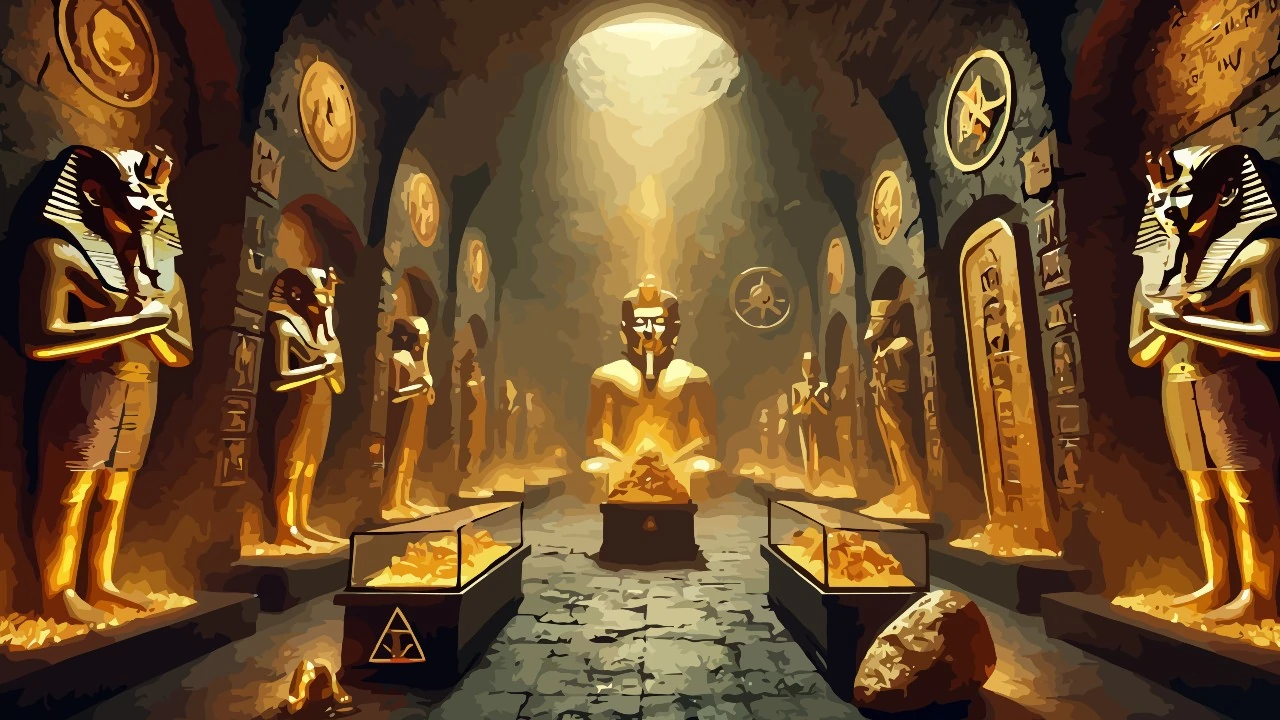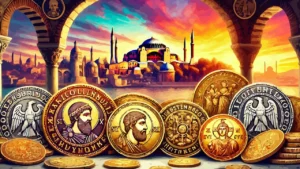Gold has given rise to unique masterpieces and extraordinary discoveries, from the majestic statue of the Golden Buddha of Wat Traimit to the Sarcophagus of Tutankhamun, a symbol of Egyptian funerary art. Extraordinary nuggets such as the Welcome Stranger and the Canaã bear witness to the grandeur of nature, while modern “artistic works” such as “America” by Cattelan transform gold into artistic provocation.
Contents
#1. Golden Buddha of Wat Traimit
5.500 kg (2.000 kg pure gold)
The Golden Buddha of Wat Traimit is one of Thailand’s most sacred and revered statues, as well as one of the most astonishing discoveries in the history of religious art. Its exact origin is uncertain, but scholars believe it was made during the Sukhothai period (1238–1438), the time when Theravada Buddhism became the dominant religion of the Sukhothai kingdom.
For centuries, the statue was completely covered in stucco and gilded plaster, a common trick to protect valuables from looters, especially during the Burmese invasions of the 18th century. It remained hidden under this covering until, in 1955, during a relocation, the outer covering accidentally broke, revealing the true nature of the statue.
After its discovery, the Buddha was placed in Wat Traimit, a temple in the Samphanthawong district of Bangkok, where it is today an object of pilgrimage and veneration. The statue depicts Buddha seated in the Bhumisparsha Mudra position, with his right hand touching the earth, a gesture that symbolizes the moment of his enlightenment under the Bodhi tree.
In the years that followed, Wat Traimit was renovated to house this extraordinary sculpture . In 2010, the temple opened a new multi-story building, dedicating an entire floor to the history and meaning of the Golden Buddha. Today, the statue is one of the most important symbols of Thai culture, combining history, faith, and mystery into one fascinating work of art.
#2. Golden Sarcophagus of Tutankhamun
110 kg (97 kg pure gold)
The Golden Sarcophagus of Tutankhamun is one of the most iconic funerary objects of Ancient Egypt, discovered in 1922 by archaeologist Howard Carter in the Valley of the Kings. The discovery of Tutankhamun’s tomb was revolutionary, as it was one of the few royal tombs that remained intact and unlooted in the millennia following its construction.
The sarcophagus was part of a complex of three sarcophagi nested inside each other, each designed to protect the body of the young pharaoh on his journey to the afterlife. The innermost, the one in solid gold, contained the mummy of Tutankhamun wrapped in precious fabrics and adorned with amulets and sacred jewels.
Decorated with extraordinary skill, the sarcophagus shows the idealized face of Tutankhamun, with the traditional nemes headdress, braided beard and eyes encrusted with precious stones. The pharaoh is depicted with his arms crossed on his chest, while holding the crook and the flail, symbols of his divine authority and his role as sovereign protector of the Egyptian people.
The inscriptions and hieroglyphics engraved on the sarcophagus contain prayers and magical formulas from the Book of the Dead, intended to ensure Tutankhamun’s protection and success in the afterlife. Its workmanship demonstrates the high level of skill achieved by Egyptian craftsmen, who used advanced techniques in working gold and precious stones.
Today, the sarcophagus is kept in the Egyptian Museum in Cairo, where it continues to amaze scholars and visitors. Its discovery contributed enormously to the knowledge of Egyptian civilization, making Tutankhamun one of the most famous pharaohs in history, despite his short reign.
#3. “America” by Maurizio Cattelan
103 kg (77 kg pure gold)
“America” by Maurizio Cattelan is one of the most provocative and discussed contemporary works of art of recent years. Created in 2016, it consists of a fully functional toilet made entirely of solid gold, conceived as an ironic critique of consumerism and economic inequality.
The work was first exhibited at the Guggenheim Museum in New York, where visitors were able to actually use it, making it one of the few contemporary “works of art” with a direct and functional interaction. The title, “America,” is a clear allusion to unbridled luxury and social inequality, highlighting the paradox of an object usually considered banal, transformed into a symbol of wealth and extreme waste.
The Guggenheim curator, in introducing the work, described it as an icon of the American dream, accessible to all, but with an incredibly high production price. The idea of transforming an everyday object into an extremely luxurious artifact reflects the conceptual approach typical of Cattelan, known for his irony and his irreverent “works”.
In 2019, the work was loaned to Blenheim Palace in England, the birthplace of Winston Churchill. However, a few hours after the opening of the exhibition, “America” was stolen in a spectacular theft. The golden toilet, being perfectly functional, was connected to the building’s plumbing, and the thieves, in removing it, caused serious structural damage.
To this day, the toilet has never been recovered and the mystery of its fate remains open. Some speculate that it was melted down for gold, while others believe it may still be hidden somewhere. Despite its physical absence, “America” continues to be one of the most daring examples of modern conceptual art, raising questions about the relationship between art, value, and contemporary society.
#4. Pepita “Welcome Stranger”
78 kg (71 kg pure gold)
The “Welcome Stranger” nugget is the largest gold nugget ever found and is one of the most extraordinary discoveries in gold rush history. It was found on February 5, 1869, near Moliagul, Victoria, Australia, by two British gold prospectors, John Deason and Richard Oates.
The discovery occurred almost by chance: the two miners, while digging in an already partially explored area, hit a mass of metal with a pickaxe a few centimeters deep. At first they thought it was a large stone, but when they examined it more closely, they realized that it was entirely made of gold.
The nugget was so large that it could not be weighed with the scales available at the time, so it had to be broken into several pieces to be transported and weighed correctly. After melting, the nugget yielded 71 kg of pure gold, which was sold to the Bank of England for a sum equivalent to millions of dollars today.
The discovery of the “Welcome Stranger” occurred at a time when the Australian gold rush was at its peak and helped make the region of Victoria one of the most important in the world for gold mining. However, the original nugget no longer exists, having been completely melted down for trade.
Today, a full-size replica of the “Welcome Stranger” is on display at the Dunolly Museum in Victoria, and her story continues to inspire prospectors and mineral enthusiasts around the world. Her discovery remains one of the most incredible ever documented in mining.
#5. Pepita “Canaã”
61 kg (58 kg pure gold)
The “Canaã” nugget is one of the largest gold nuggets still in existence and represents one of the most important discoveries in the history of Brazilian gold mining. It was found on September 13, 1983 by Júlio de Deus Filho, a miner working in the famous Serra Pelada gold field, located in the state of Pará, Brazil.
Serra Pelada became famous in the 1980s as one of the largest open-pit gold deposits in the world, attracting thousands of gold miners from all over Brazil, in search of fortune. The region quickly transformed into a chaotic mining camp, with thousands of men digging with shovels and buckets, in extremely difficult and dangerous conditions.
The “Canaã” nugget was one of the most sensational discoveries of the time. When Júlio de Deus Filho found it, the find caused a great stir, both among miners and gold merchants. Unlike many other large nuggets, the “Canaã” was not melted down and was instead destined for preservation as a symbol of Brazil’s mineral wealth.
Today, the nugget is exhibited in the Central Bank’s Museum of Values in Brasilia, where it is considered one of the most important pieces of the collection. Its existence is a rarity, as most of the large nuggets discovered in the world were melted down almost immediately after their discovery to sell for gold.
The “Canaã” represents not only a wonder of nature, but also a testimony to the golden age of Serra Pelada, when thousands of men flocked to the mines in the hope of changing their lives with a stroke of luck.
#6. Pepita “The Great Triangle”
36 kg (34 kg pure gold)
The “Great Triangle” nugget is one of the largest gold nuggets ever found and is the largest ever discovered in Russia. It was found in 1842 in the Ural region, an area known for its abundance of precious minerals since the time of the tsars.
The name “The Great Triangle” comes from its particularly distinctive shape, which resembles an almost perfect triangle, an unusual characteristic for a gold nugget of this size. This peculiarity made it immediately recognizable and helped to prevent it from being melted down, allowing it to survive to the present day.
The discovery occurred during a period when the Russian Empire was intensifying mining in the Urals region, considered one of the country’s richest gold areas. The nugget was quickly acquired by the imperial authorities, who considered it a symbol of Russia’s mineral wealth.
Unlike many other nuggets discovered in modern times, which were sold and melted down for gold, the “Great Triangle” was preserved intact and is now on display in the prestigious Diamond Museum in the Moscow Kremlin. This specimen represents a rare example of a historical nugget that has survived the test of time and is one of the main attractions of the museum, where it is kept alongside the Russian Imperial Jewels and other priceless treasures. Its discovery strengthened the reputation of the Urals as one of the richest gold regions of the Tsarist era and helped consolidate Russia’s importance in the production of precious metals.
#7. Pepita “Hand of Faith”
27 kg (25,6 kg pure gold)
The Hand of Faith nugget is one of the largest gold nuggets ever found and the largest ever discovered with a metal detector. It was discovered on September 26, 1980 by Kevin Hillier, an amateur gold prospector, near Wedderburn, Victoria, Australia. The discovery was made entirely by chance: Hillier was exploring an area already known to be rich in gold, when his metal detector emitted a very loud signal. He began to dig and, about a foot deep, discovered an irregular, glittering mass of gold.
This extraordinary nugget was immediately christened “Hand of Faith,” a name that recalls both the elongated and knobby shape of the nugget and the incredible fortune it brought to its discoverer. The news quickly spread around the world, attracting the attention of gold collectors and investors.
Shortly after its discovery, the nugget was purchased by the Golden Nugget Casino in Las Vegas, where it remains on display as a visitor attraction. Its placement in the famous casino reflects the idea of sudden wealth and a stroke of luck that were central to both gambling and the Gold Rush.
The “Hand of Faith” remains one of the most iconic and photographed gold nuggets in the world, not only for its extraordinary history, but also because it represents one of the few large nuggets to have survived intact. Its discovery is a symbol of the possibility, however remote, that extraordinary discoveries can still be made in the search for gold today.
#8. Pepita “Alaska Centennial Nugget”
20,5 kg (19,5 kg pure gold)
The Alaska Centennial Nugget is the largest gold nugget ever found in Alaska and is one of the most significant discoveries in U.S. mining history. It was discovered in 1998 by Barry Clay, a professional gold prospector, while working with an excavator along Swift Creek near Ruby, Alaska.
Unlike many other nuggets found during the gold rush of the 1800s, the “Alaska Centennial Nugget” was discovered much later, proving that Alaska continued to hide gold treasures of exceptional value. The nugget’s name celebrates the centennial of Alaska, which became a United States territory in 1898, exactly 100 years before it was discovered.
Barry Clay, realizing the incredible value of his find, did not want to risk it and decided to immediately sell the nugget to a private collector. The nugget was later purchased by a gold and mineral shop in Talkeetna, Alaska, where it remained for years as a visitor attraction.
Today, the Alaska Centennial Nugget remains one of the most famous and studied nuggets in the world, as it represents one of the rare discoveries of large nuggets in the modern era, at a time when it was thought that most of the surface gold deposits had already been exploited. Its discovery is a testament to the mineral wealth of Alaska, a region that has played a key role in the history of gold in the United States and that, even today, continues to attract miners, geologists and gold prospectors.
#9. Funerary Mask of Tutankhamun
10,2 kg (9,9 kg pure gold)
The Funerary Mask of Tutankhamun is one of the most iconic objects of Ancient Egypt and of the entire history of archaeology. It was discovered in 1922 by archaeologist Howard Carter, inside the tomb of the pharaoh Tutankhamun (KV62) in the Valley of the Kings. This tomb, unlike many others, was found almost intact, giving the world one of the most extraordinary treasures of the pharaonic era.
The mask was placed directly on the face of Tutankhamun’s mummy, as part of the funerary equipment intended to protect and guide the pharaoh in the afterlife. In ancient Egypt, it was believed that a funerary mask not only preserved the identity of the deceased, but was also a bridge between the world of the living and the divine.
The art and workmanship of the mask testify to the refined technological and artistic level achieved by Egyptian craftsmen during the XVIII dynasty. The mask depicts the young king with the traditional nemes headdress, decorated with the uraeus and the vulture, symbols of sovereignty over Lower and Upper Egypt.
The mask’s eyes are set with obsidian and quartz, while the eyebrows and eye contours are inlaid with lapis lazuli, a precious stone imported from Afghanistan. The braided beard, a symbol of divine royalty, is made of dark blue glass and detailed with gold engravings. The back and inside of the mask are engraved with passages from the “Book of the Dead,” intended to grant Tutankhamun protection and eternal life in the afterlife. This detail demonstrates not only the ritual importance of the object, but also the Egyptians’ attention to the spiritual dimension of passing.
After its discovery, the mask became one of the most famous symbols of Ancient Egypt and was exhibited in the Egyptian Museum in Cairo, where it remains one of the most visited pieces in the world. In 2015, the mask underwent restoration after an accident in which the beard was accidentally detached and then clumsily reattached with glue. The subsequent restoration returned the work to its original splendor.
Even today, the Funerary Mask of Tutankhamun enchants millions of visitors and scholars, representing a timeless symbol of the grandeur and mystery of Egyptian civilization.











Leave a Reply